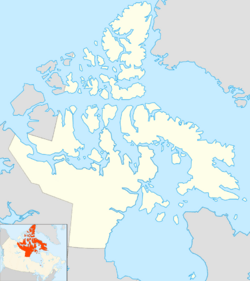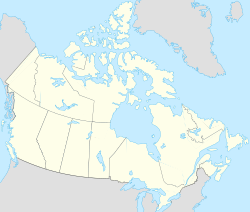Gibson Island (Nunavut) facts for kids
| Geography | |
|---|---|
| Location | Franklin Strait |
| Coordinates | 71°47′0″N 095°20′0″W / 71.78333°N 95.33333°W |
| Archipelago | Canadian Arctic Archipelago |
| Administration | |
| Territory | Nunavut |
| Region | Kitikmeot |
| Demographics | |
| Population | Uninhabited |
Gibson Island is a small, uninhabited island located far north in Canada. It is part of Nunavut, which is one of Canada's three territories. This island is found in the Kitikmeot Region, deep within the northern Canadian Arctic.
Contents
Where is Gibson Island Located?
Gibson Island sits in a body of water called Franklin Strait. This strait is a channel of water that connects larger seas in the Arctic. The island is positioned to the west of a large piece of land called the Boothia Peninsula. It is also about 26.5 kilometers (about 16.5 miles) southwest of Murchison Promontory, which is a point of land on the mainland.
Part of the Canadian Arctic Archipelago
Gibson Island is one of many islands that make up the Canadian Arctic Archipelago. This is a huge group of islands in the Arctic Ocean. These islands are mostly covered in ice and snow for much of the year. They are known for their very cold climate and unique wildlife.
Life in the Arctic Environment
Because Gibson Island is in the Arctic, it has a very cold and harsh environment. The island is uninhabited, meaning no people live there permanently. This is due to the extreme weather conditions.
Climate and Landscape
The climate on Gibson Island is polar. This means it has very long, cold winters and short, cool summers. The ground is often frozen solid, a condition called permafrost. The landscape is likely rocky and covered in tundra plants. Tundra is a type of biome where the growth of trees is prevented by low temperatures and short growing seasons.
Arctic Wildlife
Even though Gibson Island is uninhabited by humans, it is part of an important ecosystem for Arctic animals. Animals like polar bears might travel across the ice near the island. Various types of seals can be found in the surrounding waters. During the warmer months, many migratory birds might visit the island to nest. These animals are specially adapted to survive in the cold Arctic conditions.
Exploring the Arctic Islands
Islands like Gibson Island are important for understanding the Arctic environment. Scientists often study these remote areas to learn about climate change and the unique plants and animals that live there. Even though they are small and remote, these islands play a role in the vast Arctic ecosystem.



